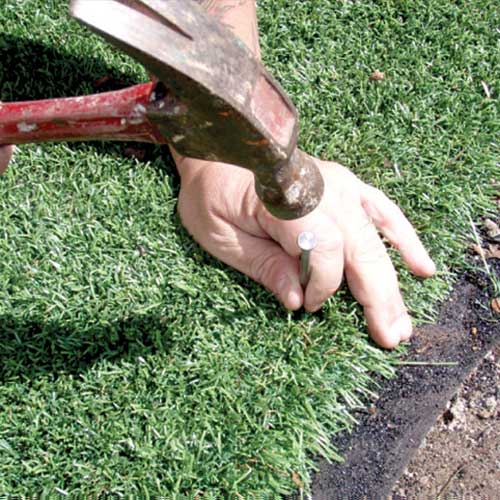Look Into the Environmental Benefits of Opting for Synthetic Grass Solutions
The fostering of fabricated grass remedies presents a compelling possibility to resolve pressing environmental challenges. By significantly minimizing water usage and lessening the application of dangerous chemicals, these options not just promote lasting landscaping but likewise shield neighborhood ecological communities.
Water Conservation Advantages
One of the most considerable advantages of fabricated grass is its capability to preserve water. In comparison, artificial lawn does not need watering, significantly lowering the general demand for water resources.
By getting rid of the need for routine watering, synthetic grass adds to lasting landscape practices and assists minimize the environmental impact of extreme water usage. The conservation of water prolongs to the decrease of drainage, which can lead to dirt erosion and waterway air pollution.
In addition, the installation of synthetic grass allows communities and home owners to allot water sources a lot more efficiently, concentrating on vital uses such as alcohol consumption water and agriculture. The change in the direction of synthetic grass not just advertises liable water usage however additionally straightens with more comprehensive ecological goals targeted at preserving all-natural sources.
As communities progressively focus on sustainability, the water conservation benefits of synthetic grass present an engaging instance for its fostering in household and industrial landscape design tasks.
Lowered Chemical Usage
The transition to fabricated lawn significantly lowers the dependence on chemical therapies generally made use of in natural lawn upkeep. Conventional turf administration generally includes the application of herbicides, pesticides, and plant foods to promote development and control parasites. These chemicals can present risks to human health, local wild animals, and the atmosphere, adding to dirt and water contamination.
In contrast, man-made grass removes the need for these hazardous materials. By minimizing the launch of artificial compounds right into the community, fabricated lawn promotes healthier dirt and water systems.
Moreover, the lack of chemical drainage connected with synthetic grass installments assists protect neighborhood rivers from air pollution, supporting marine life and preserving biodiversity. Arizona turf. As areas progressively focus on lasting practices, choosing synthetic grass provides a practical remedy that lines up with ecological preservation goals. Via this shift, homeowner can appreciate rich green rooms without endangering ecological health and wellness, paving the method for a much more lasting future
Reduced Carbon Impact

Additionally, the installment of man-made lawn can cause substantial water preservation. All-natural yards need considerable amounts of water for watering, which not just includes in the carbon footprint related to water removal and therapy yet additionally stress neighborhood water sources. In comparison, synthetic grass requires minimal upkeep, needing no watering, therefore significantly minimizing water use and its linked power expenses.
In addition, the durability of artificial lawn adds to its lower carbon influence. With a life expectancy of as much as 15 years or even more, the requirement for regular replacements is decreased, causing much less waste and reduced energy consumption in manufacturing and throwing away conventional lawn alternatives. In general, synthetic grass offers a sustainable choice for environmentally aware landscaping.
Environment Preservation
Environment preservation is a critical consideration in the argument over landscape design choices, especially when contrasting synthetic grass to all-natural lawn. All-natural lawn yards frequently need substantial upkeep, consisting of making use of pesticides, plant foods, and herbicides, which can negatively impact regional ecosystems. These chemicals can seep into the dirt and waterways, hurting indigenous plants and fauna and interrupting neighborhood environments.
In comparison, synthetic grass provides an opportunity to reduce the ecological footprint of landscape design. By going with artificial turf, house owners can minimize the disruption of natural environments connected with traditional yard care methods. Synthetic grass removes the requirement for damaging chemicals, thereby shielding close-by wildlife and preserving the stability of surrounding environments. Furthermore, the installation of artificial grass can result in the conversion of previous yard locations into even more biodiverse landscapes, such as pollinator gardens or indigenous plant locations, which can sustain regional wildlife.
Ultimately, the transition to synthetic grass not only preserves water and reduces upkeep efforts however additionally fosters a more unified connection in between human activities and the natural surroundings, promoting environment preservation while doing so.
Long-Term Sustainability
Long-lasting sustainability is an important element in evaluating the benefits of synthetic grass over traditional grass yards. One of one of the most significant advantages of synthetic turf is its longevity; it can last up to 15-20 years with marginal maintenance, whereas all-natural lawn needs regular reseeding and replacement. This durability decreases the need for constant resources, such as water, plant foods, and chemicals, which are crucial for preserving a healthy and balanced grass lawn.
In addition, synthetic grass adds to a decrease in carbon emissions related to lawn care devices. Typical grass commonly require gas-powered mowers, trimmers, and blowers, every one of which contribute to air contamination. Arizona see here now turf. On the other hand, synthetic grass removes the demand for such devices, promoting a cleaner environment
Moreover, the production of synthetic turf significantly makes use of recycled materials, improving its sustainability profile. As makers adopt environmentally friendly methods, the ecological footprint of synthetic grass continues to check my site decrease.

Conclusion
The adoption of synthetic grass options presents substantial ecological benefits, including substantial water preservation, decreased reliance on damaging chemicals, and a reduced carbon impact. In addition, fabricated turf help in maintaining natural environments by decreasing land disturbance and advertising long-lasting sustainability with the usage of sturdy materials. Collectively, these aspects highlight the potential of synthetic grass to contribute positively to ecological wellness and use a sensible choice to standard landscaping techniques in a significantly resource-conscious world.
In comparison, man-made turf does not require watering, dramatically lowering the overall need for water resources. By decreasing the release of artificial compounds right into the ecosystem, fabricated grass promotes healthier dirt and water systems.
Additionally, the installation of fabricated turf can result in significant water conservation. In contrast, artificial grass requires minimal upkeep, requiring no watering, thereby substantially reducing water usage and its connected energy costs.
